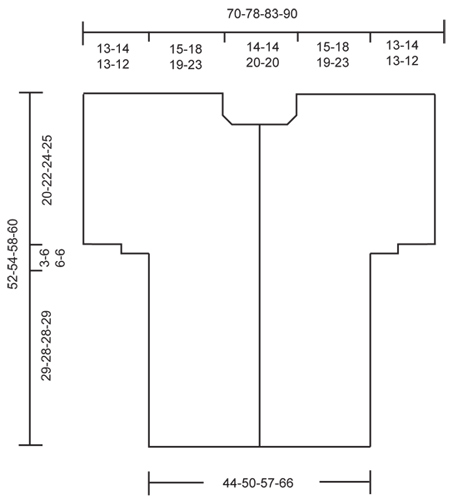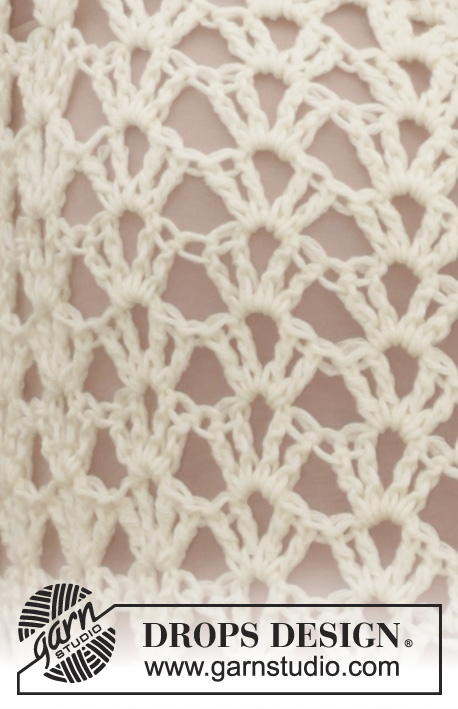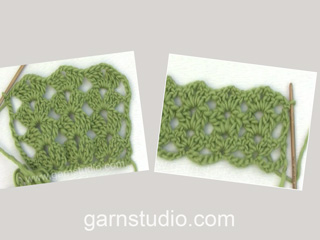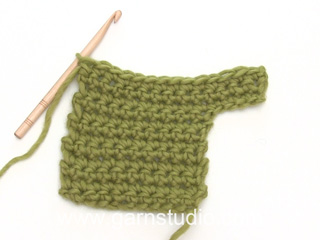Verano |
|||||||||||||||||||
|
|
|||||||||||||||||||
Crochet DROPS jacket with lace pattern and double treble crochet in ”Cotton Merino”. Size: S - XXXL.
DROPS 153-14 |
|||||||||||||||||||
|
CROCHET INFO: Replace first dtr at beg of every dtr row with 4 ch. PATTERN: See diagrams A.1 - A.5. CROCHET TIP: ROW 1 in diagram A.4 and A.5 are not worked on back piece but on front piece. BUTTONHOLES: Do not dec for buttonholes but sew the buttons on to left band and button between two dtr/triple tr in right band. Sew on buttons measured from cast-on edge as follows: SIZE S/M: 12, 20, 28, 36 and 44 cm SIZE L/XL: 14, 22, 30, 38 and 46 cm SIZE XXL: 10, 20, 30, 40 and 50 cm SIZE XXXL: 12, 22, 32, 42 and 52 cm ---------------------------------------------------------- BACK PIECE: Worked back and forth. Work 83-95-108-120 ch on hook size 5 mm with Cotton Merino. Work first row as follows (= WS): 1 dc in 2nd ch from hook = 1 dc, 1 dc in each of the next 1-3-1-3 ch, * skip 1 ch, 1 dc in each of the next 4 ch *, repeat from *-* 16-18-21-23 times = 66-76-86-96 dc. Continue to work as follows: ROW 1 (= RS): Work A.1 1 time, then work A.2 until 8 dc remain (= 10-12-14-16 times in width) and finish with A.3 1 time. REMEMBER THE CROCHET TENSION! ROW 2 (= WS): Turn piece and work A.3 1 time, A.2 (= 10-12-14-16 times in width), A.1 1 time. ROW 3 (= RS): Turn piece and work A.1 1 time, A.2 (= 10-12-14-16 times in width), A.3 1 time. Repeat 2nd and 3rd row until piece measures approx. 29-28-28-29 cm - adjust to finish with 3rd row (= RS). Fasten off. Continue to work as follows: * Work 10-5-5-5 loose ch, beg from WS and continue A.3, A.2 and A.1 over back piece as before and finish with 10-5-5-5 loose ch, turn piece. Continue to work as follows: ROW 1 (= RS): Work 5 ch, in 10th ch from hook work 2 dtr + 2 ch + 2 dtr (= 1 repetition of A.1), work A.2 2-1-1-1 time (work last repetition of A.2 around the 2 ch in A.1 from previous row). Then continue with A.2 10-12-14-16 times in total over the entire back piece as before and finish row as follows: Work A.2 around the 2 ch in A.3 from previous row, then continue with A.2 1-0-0-0 times, and then A.3 the last 1 dtr will be in 1st ch on previous row. Cut the yarn and turn piece *, in size L/XL – XXL – XXXL repeat *-* 1 more time, AT THE SAME TIME work 2 extra repetitions of A.2 over back piece. I.e. work 1 extra repetition of A.2 over the inc repetition from previous row in each side of piece = 16-18-20 repetitions in total of A.2 in size L/XL – XXL – XXXL. Do not repeat *-* in size S/M but continue as explained below: Work 13-13-13-13 loose ch, beg from WS and continue with A.2 in ch-space from A.3 on previous row, A.2 over sleeves and back piece as before, and A.2 in ch-space in A.1 on previous row and finish with 13-13-13-13 loose ch. Continue to work as follows: ROW 1 (= RS): Work A.1 and A.2 1 time over the new sts. Continue with A.2 over sleeves and back piece as before and finish with 1 repetition of A.2 and A.3. Continue this pattern until piece measures approx. 49-51-55-57 cm - adjust to finish after a row from WS. Then finish each shoulder separately as follows: RIGHT SHOULDER: Work A.1 1 time and A.2 5-6-6-7 times in total, then work 2nd row of diagram A.4 – READ CROCHET TIP! Turn and work 3rd row of A.4, and continue row with A.2 and A.1 as before. Continue like this until piece measures 52-54-58-60 cm in total. Fasten off. LEFT SHOULDER: Work left shoulder the same way but reversed, and work A.3 instead of A.1 and 2nd row of A.5 instead of A.4. Beg with 2nd row of A.5 in the middle of row, so that there are 4-4-6-6 repetitions of A.2 in width for neck. RIGHT FRONT PIECE: Worked back and forth. Work 45-52-58-64 ch on hook size 5 mm with Cotton Merino. Work first row as follows (= WS): 1 dc in 2nd ch from hook, 1 dc in each of the next 4-1-2-3 ch, * skip 1 ch, 1 dc in each of the next 4 ch *, repeat from *-* 7-9-10-11 times in total and finish with 1 dc in each of the next 4 ch = 37-42-47-52 dc. ROW 1 (= RS): 4 ch (= 1 dtr), 1 dtr in each of the next 3 dc (= 4 dtr for band) NOTE: Work band with every other row dtr and triple tr. Then work A.2 5-6-7-8 times in total, finish with A.3 1 time. Repeat this pattern, with 4 dtr/triple tr for band towards mid front until piece measures approx. 29-28-28-29 cm – adjust according to back piece and finish with a row from RS. Fasten off. Then work 10-5-5-5 loose ch for sleeve and continue as on back piece. When piece measures 42-44-46-48 cm, work as follows on 1st row from WS: Pattern as before until 3 repetitions of A.2 and 4 dtr remain. Work pattern according to diagram A.5 over these sts. Turn and work A.5, continue row with pattern as before. Continue like this back and forth until piece measures 52-54-58-60 cm in total. Fasten off. LEFT FRONT PIECE: Work as right but reversed. Work according to diagram A.1 instead of A.3, and when neck dec beg, work according to A.4 instead of A.5. ASSEMBLY: Place front piece on top of back piece and work the shoulders as follows: * 1 dc through both layers, 3 ch, skip 2 dtr *, repeat from *-*. Work the sides tog as follows: 1 dc, * 3 ch, 1 dc in ch-space on next row *, repeat from *-*. Work tog under sleeves as follows: * 1 dc in ch in next dtr-group, 3 ch *, repeat from *-* and finish with 1 dc. Sew buttons on left band and button through two dtr/triple tr in right band. NECK EDGE: Work a neck edge as follows, beg from WS: ROW 1: Fasten yarn with 1 dc at the edge, * 3 ch, skip approx. 2 cm, 1 dc *, repeat from *-* around the entire neck edge. Turn piece. ROW 2: 4 ch, 3 dtr in first ch-space, * 3 dtr in next ch-space *, repeat from *-* along the entire row, and finish with 1 dtr in first ch on previous row. Turn piece. ROW 3: * 3 ch, skip 3 dtr, 1 dc between the next two dtr-groups *, repeat from *-* along the entire row. Turn piece. ROW 4: 2 ch, 1 dc in first ch-space, * 2 ch, 1 dc in next ch-space *, repeat from *-* along the entire row. Fasten off. |
|||||||||||||||||||
Diagram explanations |
|||||||||||||||||||
|
|||||||||||||||||||

|
|||||||||||||||||||

|
|||||||||||||||||||
|
Have you made this or any other of our designs? Tag your pictures in social media with #dropsdesign so we can see them! Do you need help with this pattern?You'll find tutorial videos, a Comments/Questions area and more by visiting the pattern on garnstudio.com. © 1982-2024 DROPS Design A/S. We reserve all rights. This document, including all its sub-sections, has copyrights. Read more about what you can do with our patterns at the bottom of each pattern on our site. |
|||||||||||||||||||













































Comments / Questions (108)
Begrijp ik het goed dat er dus geen beginstokjes / losse keten aan het begin en eind van de toer wordt gehaakt? De vijf losse waar je mee begint, hangen dan zo raar langs het achterpand. Groetjes, Renée
20.05.2015 - 21:23DROPS Design answered:
Hoi Renée. Je begint elke toer met 5 lossen (ter vervanging van 1 dstk + 1 l), en je eindigt elke toer met 1 dstk in de 4e l van de vorige toer. Zie ook het telpatroon
21.05.2015 - 15:46Als je na het afhechten van het rugpand de 5 losse hebt gehaakt (maat M), moet je dan de losse aanhechten in de 2e losse van de vorige toer en dan 5 losse haken om een nieuw dubbel stokje voor de volgende toer te haken. Of haak je 5 losse en nog eens 5 losse van A3 verkeerde kant. Groetjes, Renee
16.05.2015 - 14:58DROPS Design answered:
Hoi Renee. Je begint met de 5 lossen en volgt dan patroon A.3 - dus na de 5 l heb je 2 dstk + 2 l + 2 dstk om de l-boog van de vorige toer (je haakt door zoals eerst). enzovoort
20.05.2015 - 12:58Hallo, ich bleibe in der Anleitung leider beim Rückenteil hängen. Nach den ca. 28 cm (Größe L/XL) habe ich den Faden abgeschnitten und beginne mit 5 neuen LM. Wie geht es aber dann weiter? Verbinde ich erst die neuen LM mittels Kettmasche o.ä. mit dem Rückenteil und fahre dann mit 4+1 LM von Muster A.3 fort? Das ist mir leider nicht klar. Vielen Dank für Ihre Hilfe!
06.05.2015 - 21:42DROPS Design answered:
Sie brauchen die 5 Lm nicht zu verbinden, sondern häkeln statt der 4 Ersatz-Lm direkt ein D-Stb (ab der Rück-R) in das Rückenteil.
05.07.2015 - 09:26Jeg forstår simpelthen ikke dette: "VENSTRE SKULDER: Hækl den venstre skulder på samme måde men modsat, og der hækles A.3 i stedet for A.1 og 2.række af A.5 i stedet for A.4. Start med 2.række af A.5 midt på rækken, så der bliver 4-4-6-6 rapporter af A.2 i bredden til hals." skal skuldrene ikke se egens ud? Hvad menes der med at jeg skal starte med 2.række af A.5 "midt" på rækken? Skal jeg lave kædemasker, og hvor? Vh. Ane
27.04.2015 - 19:32DROPS Design answered:
Hej Ane, Jo men for at få den venstre skulder spejsvendt, så det bliver ens mod midt foran, så skal du følge de andre diagrammer ifølge opskriften. God fornøjelse!
13.05.2015 - 12:25Hallo, Ben er nog niet uit! Ben nog niet aan de schouders beland. In de uitleg staat : Hecht af. Ga verder en haak als volgt: * haak 10-5-5-5 losse l, begin aan de verkeerde kant en ga verder A.3, A.2 en A.1 over het achterpand als hiervoor en eindig met 10-5-5-5 losse l, keer het werk. Ga verder en haak als volgt; En hier geraak ik niet uit. Dus draad afhechten, dan 5 losse haken, maar hoe maak je dit terug vast aan het werk? Sorry voor de vele vragen.
14.04.2015 - 21:12DROPS Design answered:
Hoi Barbara. Oké, nu zie ik ook wat je bedoeld. Eerlijk gezegd, dan denk ik niet dat je hier moet afhechten (ik ga dat even verder sturen om hier opheldering over te krijgen). Ik zou gewoon keren na de 3e toer en haken zoals beschreven. De 5 l lijkt voor mij de lus om in te meerderen en verder gewoon het patroon netjes boven elkaar te haken.
15.04.2015 - 15:40Hecht af. Hallo, Ik ben met dit vestje begonnen en bij het achterpand beland daar waar je moet afhechten. Dan moet ik dus 5 losse maken, mar begrijp niet goed hoe ik dan verder moet?? Word achterpand in 2 delen gemaakt? Of direct eraan verder doen? Zoja, kan je me meer uitleg geven want geraak er niet uit? Alvast bedankt!
13.04.2015 - 23:04DROPS Design answered:
Hoi Barbara. Je haakt het achterpand in één deel tot aan het opdelen voor de hals (de halslijn zie je ook op de maattekening onderaan). Je haakt dan een aantal toeren apart over de linker schouder/mouw en de rechterschouder/mouw. Je haakt dus niet meer over de middelste 4-4-6-6 herhalingen van A.2 in het midden (=hals). Je haakt volgens de beschrijving onder eerst RECHTERSCHOUDER. Als je klaar bent, breek je de draad en haakt volgens de beschrijving voor de LINKERSCHOUDER aan de andere kant van het achterpand.
14.04.2015 - 16:55Mayaveena wrote:
HI,Thanks for this beautiful pattern.I finished mine with cotton merino .It came out well..but sleeves r short.Anyway i love this..Thanks once again for this clear pattern n chart.keep going.
19.03.2015 - 12:38Yeah! I finished this little sweater in lilac cotton merino. Lovely yarn to work with and washed up nice. The sleeves came out much shorter than picture. I added the same stitching as around the neck on the bottom of sleeves to extend them. Came out nice and will be a sweet little summer jacket. Thank you for the pattern.
18.03.2015 - 22:28Liebes Team, Ich stecke gerade an der linken Schulter und begreife die Vorgehensweise einfach nicht, wo beginne ich mit der ersten reihe der linken Schulter und wie geht es danach weiter?
14.12.2014 - 15:14DROPS Design answered:
Die 1. R der linken Schulter besteht ja aus folgenden Bestandteilen: A.5 (die 2. R von A.5), A.2 und A.3. Sie beginnen mit einer Hin-R mitten in der R ab der Stelle, an der Sie mit A.4 bei der rechten Schulter geendet haben, und häkeln bis zum Lm-Bogen, in den Sie A.5 häkeln müssen, Kett-M. Dann häkeln Sie A.5 (d.h. die 2. R, siehe Startpfeil), A.2 und A.3. Damit sind Sie wieder am Ärmelrand angelangt. In der Mitte befinden sich nun 4 bzw. 6 Rapporte (je nach Größe) von A.2, die nicht behäkelt wurden und den Halsausschnitt bilden.
06.03.2015 - 11:56Piret wrote:
Just finished this pattern. Easy and beautiful. My sleeves are not so long as they are on that picture but i love it.
04.11.2014 - 20:31